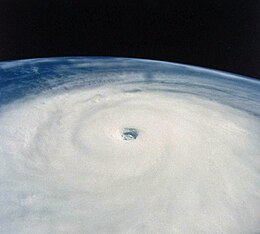Typhoon Yuri (1991)
| Typhoon (JMA scale) | |
|---|---|
| Category 5 (Saffir–Simpson scale) | |

Super Typhoon Yuri at peak intensity
|
|
| Formed | November 17, 1991 |
| Dissipated | December 4, 1991 |
| (Extratropical after December 1, 1991) | |
| Highest winds |
10-minute sustained: 220 km/h (140 mph) 1-minute sustained: 280 km/h (175 mph) |
| Lowest pressure | 895 hPa (mbar); 26.43 inHg |
| Fatalities | None |
| Damage | $36 million (1991 USD) |
| Areas affected | Pohnpei, Guam |
| Part of the 1991 Pacific typhoon season | |
Super Typhoon Yuri was a powerful Category 5 tropical cyclone that formed in November 1991. It was the strongest storm in 1991. The nineteenth typhoon and final super typhoon of the 1991 Pacific typhoon season, it formed as a tropical depression on November 22, about 1,590 kilometers east of Truk Island. Moving rather slowly at first, the system continued to intensify, and was given the name Yuri. It had become a severe tropical storm about 1,480 kilometers east of Truk Island and took on a west-northwestward track at 22 km/h. Typhoon intensity was attained that night when Yuri was 1,050 km east of Truk Island. Yuri turned more to the west on 26 November and reached peak intensity the following morning packing winds of over 220 km/h near its centre. Moving northwestwards at 30 km/h, Yuri passed 140 km to the south-southwest of Guam on the evening of November 27. After recurving November 29, Yuri accelerated northeastwards on 30 November and weakened to a severe tropical storm that night. By the morning of December 1, it had degenerated into a tropical storm about a few hundred kilometers east-northeast of Iwo Jima. Extratropical transition was completed soon afterwards.
Although Yuri never directly made landfall, it still had managed to cause $3 million (1991 USD) in damage to Pohnpei, including the loss of a radio tower. In Guam, the storm caused extensive beach erosion and destroyed between 60 and 350 buildings. There, damage totaled to $33 million (1991 USD). It is one of the most closely observed storms ever, its eye was studied for research.
In mid-November, the presence of low-level westerlies in the central Pacific provided suitable atmospheric conditions for tropical cyclogenesis. The rapid development of thunderstorm activity near the Marshall Islands on November 16 prompted the Joint Typhoon Warning Center (JTWC) to monitor the area for signs of development. The disturbance tracked slowly in a counter-clockwise loop over the next few days as it slowly organized, and at 0000 UTC on November 22, the Japan Meteorological Agency (JMA) classified the system as a tropical depression, with the JTWC following suit about a day later. Upon becoming classified as a tropical cyclone, the disturbance intensified at a fast pace, reaching tropical storm strength based on satellite intensity estimates on November 23. Yuri later reached typhoon intensity at 1200 UTC on November 24 located roughly 335 km (210 mi) east of Pohnpei while exhibiting an eye.
...
Wikipedia
